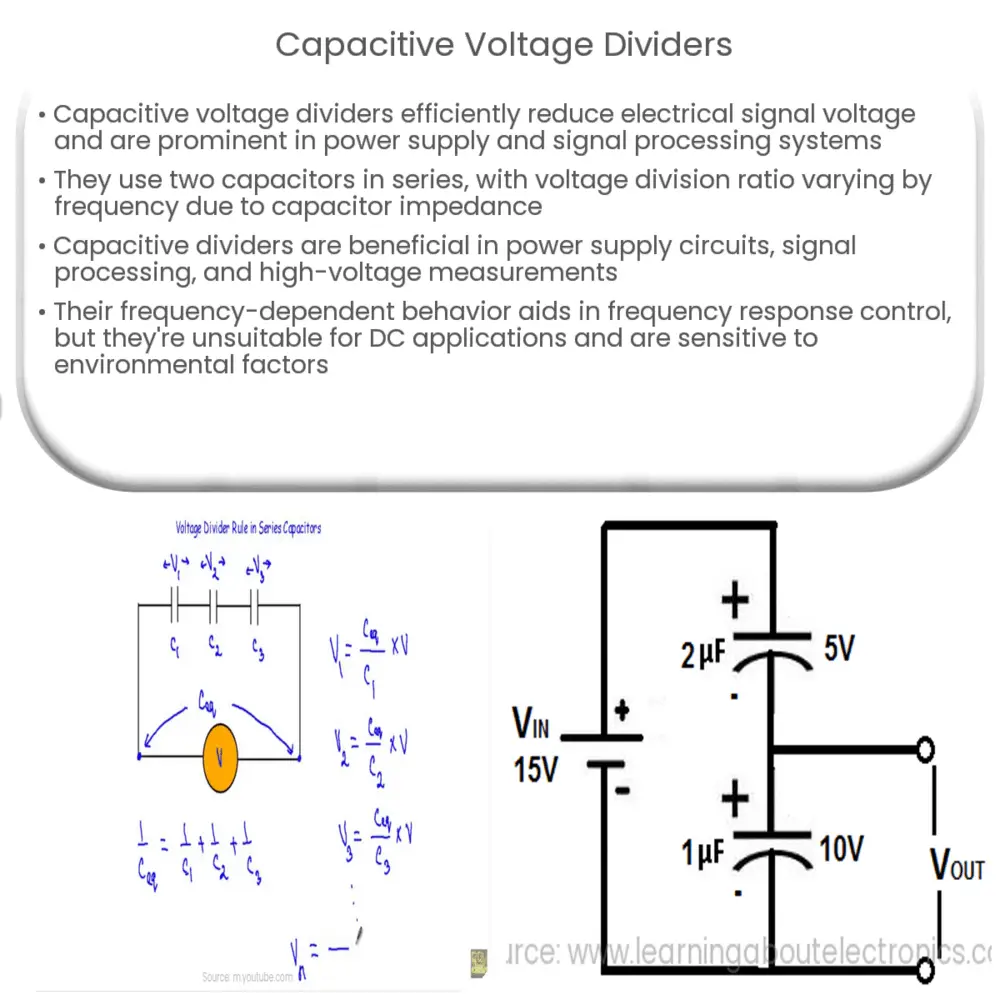Explore the functionality of capacitive voltage dividers, their frequency-dependent behavior, applications, benefits, and limitations in electrical systems.

Introduction
Capacitive voltage dividers are essential components within the realm of electrical engineering, offering an efficient and highly accurate method of reducing the voltage of an electrical signal. They can be seen in various applications, from power supply circuits to signal processing systems.
Principle of Operation
At the heart of a capacitive voltage divider are two capacitors arranged in series. As we know, a capacitor is a passive electrical component that stores electrical energy in an electric field. The fundamental principle of operation behind capacitive voltage dividers relies on this energy storage capability of capacitors.
The ratio of voltages across the capacitors in the divider is directly proportional to their capacitance values. By carefully choosing these capacitance values, we can achieve the desired voltage division ratio. However, it’s crucial to note that unlike resistive dividers, the voltage division ratio in a capacitive divider varies with frequency due to the frequency-dependent impedance of capacitors.
Capacitive Voltage Divider Circuit
Consider a simple capacitive voltage divider circuit consisting of two capacitors, C1 and C2, connected in series across a voltage source Vin. The output voltage Vout is taken across C2.
- The total impedance Zt of the series combination of capacitors is given by:
- The voltage across C1 (V1) and C2 (V2) are then:
- Since Vout = V2, the voltage division ratio becomes:
Zt = 1 / (jwC1) + 1 / (jwC2)
V1 = Vin * Zt / (1 / (jwC1))
V2 = Vin * Zt / (1 / (jwC2))
Vout/Vin = (1 / (jwC2)) / (1 / (jwC1) + 1 / (jwC2))
These equations illustrate that the output voltage Vout is indeed a fraction of the input voltage Vin, with the fraction determined by the values of the capacitors.
Frequency Dependence
The capacitive voltage divider’s frequency dependence stems from the fact that a capacitor’s impedance is inversely proportional to the frequency of the applied signal. Consequently, the voltage division ratio changes as the frequency of the input signal changes. This characteristic is particularly useful in applications where frequency response control is necessary.
Applications of Capacitive Voltage Dividers
Due to their unique properties, capacitive voltage dividers find widespread use in various fields of electronics.
- Power Supply Circuits: Capacitive voltage dividers are commonly used in power supply circuits, particularly in switching power supplies, to reduce the voltage to a level safe for the devices being powered.
- Signal Processing: In signal processing systems, capacitive voltage dividers are employed to adjust signal levels. Their frequency dependence can be exploited to implement filters for specific frequency ranges.
- Measurement Systems: In high-voltage measurement systems, capacitive voltage dividers are used to step down the voltage to levels that can be safely handled by measurement instruments.
Advantages and Disadvantages
Capacitive voltage dividers offer several advantages, but they also come with some challenges.
- Low Power Dissipation: As capacitors store rather than dissipate energy, capacitive dividers offer lower power dissipation compared to their resistive counterparts. This makes them desirable in power-sensitive applications.
- Frequency Selectivity: The frequency-dependent behavior of capacitive dividers can be a blessing in applications where frequency selectivity is required, such as in filters and signal processing.
- Impedance Matching: Capacitive voltage dividers can also be used in impedance matching applications to maximize power transfer.
- Limitations: On the downside, capacitive dividers are not suitable for DC applications because capacitors block DC current. Moreover, their performance can be affected by environmental factors like temperature and humidity.
Conclusion
Capacitive voltage dividers are fundamental components in electrical and electronic systems. They operate on the energy storage principle of capacitors and offer an efficient way of achieving voltage division, especially in AC circuits. While they have inherent frequency-dependent behavior that can be advantageous in certain applications, it also poses challenges that need to be managed in circuit design. Regardless, the versatility and usefulness of capacitive voltage dividers make them a valuable tool in the electrical engineer’s toolkit.

